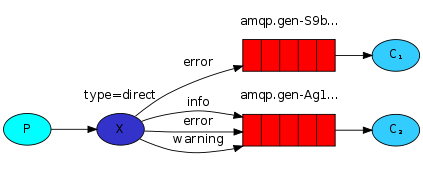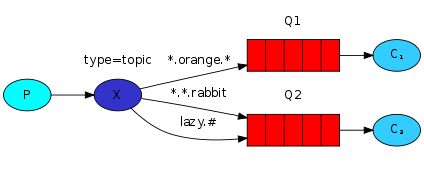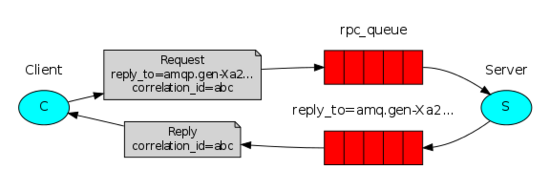Python實現RabbitMQ6種消息模型的示例代碼
RabbitMQ與Redis對比
RabbitMQ是一種比較流行的消息中間件,之前我一直使用redis作為消息中間件,但是生產環境比較推薦RabbitMQ來替代Redis,所以我去查詢了一些RabbitMQ的資料。相比于Redis,RabbitMQ優點很多,比如:
具有消息消費確認機制 隊列,消息,都可以選擇是否持久化,粒度更小、更靈活。 可以實現負載均衡RabbitMQ應用場景
異步處理:比如用戶注冊時的確認郵件、短信等交由rabbitMQ進行異步處理 應用解耦:比如收發消息雙方可以使用消息隊列,具有一定的緩沖功能 流量削峰:一般應用于秒殺活動,可以控制用戶人數,也可以降低流量 日志處理:將info、warning、error等不同的記錄分開存儲RabbitMQ消息模型
這里使用 Python 的 pika 這個庫來實現RabbitMQ中常見的6種消息模型。沒有的可以先安裝:
pip install pika
1.單生產單消費模型:即完成基本的一對一消息轉發。

# 生產者代碼import pikacredentials = pika.PlainCredentials(’chuan’, ’123’) # mq用戶名和密碼,沒有則需要自己創建# 虛擬隊列需要指定參數 virtual_host,如果是默認的可以不填。connection = pika.BlockingConnection(pika.ConnectionParameters(host=’localhost’,port=5672,virtual_host=’/’,credentials=credentials))# 建立rabbit協議的通道channel = connection.channel()# 聲明消息隊列,消息將在這個隊列傳遞,如不存在,則創建。durable指定隊列是否持久化channel.queue_declare(queue=’python-test’, durable=False)# message不能直接發送給queue,需經exchange到達queue,此處使用以空字符串標識的默認的exchange# 向隊列插入數值 routing_key是隊列名channel.basic_publish(exchange=’’, routing_key=’python-test’, body=’Hello world!2’)# 關閉與rabbitmq server的連接connection.close()
# 消費者代碼import pikacredentials = pika.PlainCredentials(’chuan’, ’123’)# BlockingConnection:同步模式connection = pika.BlockingConnection(pika.ConnectionParameters(host=’localhost’,port=5672,virtual_host=’/’, credentials=credentials))channel = connection.channel()# 申明消息隊列。當不確定生產者和消費者哪個先啟動時,可以兩邊重復聲明消息隊列。channel.queue_declare(queue=’python-test’, durable=False)# 定義一個回調函數來處理消息隊列中的消息,這里是打印出來def callback(ch, method, properties, body): # 手動發送確認消息 ch.basic_ack(delivery_tag=method.delivery_tag) print(body.decode()) # 告訴生產者,消費者已收到消息# 告訴rabbitmq,用callback來接收消息# 默認情況下是要對消息進行確認的,以防止消息丟失。# 此處將auto_ack明確指明為True,不對消息進行確認。channel.basic_consume(’python-test’, on_message_callback=callback) # auto_ack=True) # 自動發送確認消息# 開始接收信息,并進入阻塞狀態,隊列里有信息才會調用callback進行處理channel.start_consuming()
2.消息分發模型:多個收聽者監聽一個隊列。

# 生產者代碼import pikacredentials = pika.PlainCredentials(’chuan’, ’123’) # mq用戶名和密碼# 虛擬隊列需要指定參數 virtual_host,如果是默認的可以不填。connection = pika.BlockingConnection(pika.ConnectionParameters(host=’localhost’,port=5672,virtual_host=’/’,credentials=credentials))# 建立rabbit協議的通道channel = connection.channel()# 聲明消息隊列,消息將在這個隊列傳遞,如不存在,則創建。durable指定隊列是否持久化。確保沒有確認的消息不會丟失channel.queue_declare(queue=’rabbitmqtest’, durable=True)# message不能直接發送給queue,需經exchange到達queue,此處使用以空字符串標識的默認的exchange# 向隊列插入數值 routing_key是隊列名# basic_publish的properties參數指定message的屬性。此處delivery_mode=2指明message為持久的for i in range(10): channel.basic_publish(exchange=’’, routing_key=’python-test’, body=’Hello world!%s’ % i, properties=pika.BasicProperties(delivery_mode=2))# 關閉與rabbitmq server的連接connection.close()
# 消費者代碼,consume1與consume2import pikaimport timecredentials = pika.PlainCredentials(’chuan’, ’123’)# BlockingConnection:同步模式connection = pika.BlockingConnection(pika.ConnectionParameters(host=’localhost’,port=5672,virtual_host=’/’,credentials=credentials))channel = connection.channel()# 申明消息隊列。當不確定生產者和消費者哪個先啟動時,可以兩邊重復聲明消息隊列。channel.queue_declare(queue=’rabbitmqtest’, durable=True)# 定義一個回調函數來處理消息隊列中的消息,這里是打印出來def callback(ch, method, properties, body): # 手動發送確認消息 time.sleep(10) print(body.decode()) # 告訴生產者,消費者已收到消息 ch.basic_ack(delivery_tag=method.delivery_tag)# 如果該消費者的channel上未確認的消息數達到了prefetch_count數,則不向該消費者發送消息channel.basic_qos(prefetch_count=1)# 告訴rabbitmq,用callback來接收消息# 默認情況下是要對消息進行確認的,以防止消息丟失。# 此處將no_ack明確指明為True,不對消息進行確認。channel.basic_consume(’python-test’, on_message_callback=callback) # auto_ack=True) # 自動發送確認消息# 開始接收信息,并進入阻塞狀態,隊列里有信息才會調用callback進行處理channel.start_consuming()
3.fanout消息訂閱模式:生產者將消息發送到Exchange,Exchange再轉發到與之綁定的Queue中,每個消費者再到自己的Queue中取消息。

# 生產者代碼import pikacredentials = pika.PlainCredentials(’chuan’, ’123’) # mq用戶名和密碼# 虛擬隊列需要指定參數 virtual_host,如果是默認的可以不填。connection = pika.BlockingConnection(pika.ConnectionParameters(host=’localhost’,port=5672,virtual_host=’/’,credentials=credentials))# 建立rabbit協議的通道channel = connection.channel()# fanout: 所有綁定到此exchange的queue都可以接收消息(實時廣播)# direct: 通過routingKey和exchange決定的那一組的queue可以接收消息(有選擇接受)# topic: 所有符合routingKey(此時可以是一個表達式)的routingKey所bind的queue可以接收消息(更細致的過濾)channel.exchange_declare(’logs’, exchange_type=’fanout’)#因為是fanout廣播類型的exchange,這里無需指定routing_keyfor i in range(10): channel.basic_publish(exchange=’logs’, routing_key=’’, body=’Hello world!%s’ % i)# 關閉與rabbitmq server的連接connection.close()
import pikacredentials = pika.PlainCredentials(’chuan’, ’123’)# BlockingConnection:同步模式connection = pika.BlockingConnection(pika.ConnectionParameters(host=’localhost’,port=5672,virtual_host=’/’,credentials=credentials))channel = connection.channel()#作為好的習慣,在producer和consumer中分別聲明一次以保證所要使用的exchange存在channel.exchange_declare(exchange=’logs’, exchange_type=’fanout’)# 隨機生成一個新的空的queue,將exclusive置為True,這樣在consumer從RabbitMQ斷開后會刪除該queue# 是排他的。result = channel.queue_declare(’’, exclusive=True)# 用于獲取臨時queue的namequeue_name = result.method.queue# exchange與queue之間的關系成為binding# binding告訴exchange將message發送該哪些queuechannel.queue_bind(exchange=’logs’, queue=queue_name)# 定義一個回調函數來處理消息隊列中的消息,這里是打印出來def callback(ch, method, properties, body): # 手動發送確認消息 print(body.decode()) # 告訴生產者,消費者已收到消息 #ch.basic_ack(delivery_tag=method.delivery_tag)# 如果該消費者的channel上未確認的消息數達到了prefetch_count數,則不向該消費者發送消息channel.basic_qos(prefetch_count=1)# 告訴rabbitmq,用callback來接收消息# 默認情況下是要對消息進行確認的,以防止消息丟失。# 此處將no_ack明確指明為True,不對消息進行確認。channel.basic_consume(queue=queue_name, on_message_callback=callback, auto_ack=True) # 自動發送確認消息# 開始接收信息,并進入阻塞狀態,隊列里有信息才會調用callback進行處理channel.start_consuming()
4.direct路由模式:此時生產者發送消息時需要指定RoutingKey,即路由Key,Exchange接收到消息時轉發到與RoutingKey相匹配的隊列中。

# 生產者代碼,測試命令可以使用:python produce.py error 404errorimport pikaimport sysconnection = pika.BlockingConnection(pika.ConnectionParameters(host=’localhost’))channel = connection.channel()# 聲明一個名為direct_logs的direct類型的exchange# direct類型的exchangechannel.exchange_declare(exchange=’direct_logs’, exchange_type=’direct’)# 從命令行獲取basic_publish的配置參數severity = sys.argv[1] if len(sys.argv) > 1 else ’info’message = ’ ’.join(sys.argv[2:]) or ’Hello World!’# 向名為direct_logs的exchage按照設置的routing_key發送messagechannel.basic_publish(exchange=’direct_logs’, routing_key=severity, body=message)print(' [x] Sent %r:%r' % (severity, message))connection.close()
# 消費者代碼,測試可以使用:python consume.py errorimport pikaimport sysconnection = pika.BlockingConnection(pika.ConnectionParameters(host=’localhost’))channel = connection.channel()# 聲明一個名為direct_logs類型為direct的exchange# 同時在producer和consumer中聲明exchage或queue是個好習慣,以保證其存在channel.exchange_declare(exchange=’direct_logs’, exchange_type=’direct’)result = channel.queue_declare(’’, exclusive=True)queue_name = result.method.queue# 從命令行獲取參數:routing_keyseverities = sys.argv[1:]if not severities: print(sys.stderr, 'Usage: %s [info] [warning] [error]' % (sys.argv[0],)) sys.exit(1)for severity in severities: # exchange和queue之間的binding可接受routing_key參數 # fanout類型的exchange直接忽略該參數。direct類型的exchange精確匹配該關鍵字進行message路由 # 一個消費者可以綁定多個routing_key # Exchange就是根據這個RoutingKey和當前Exchange所有綁定的BindingKey做匹配, # 如果滿足要求,就往BindingKey所綁定的Queue發送消息 channel.queue_bind(exchange=’direct_logs’, queue=queue_name, routing_key=severity)def callback(ch, method, properties, body): print(' [x] %r:%r' % (method.routing_key, body,))channel.basic_consume(queue=queue_name, on_message_callback=callback, auto_ack=True)channel.start_consuming()
5.topic匹配模式:更細致的分組,允許在RoutingKey中使用匹配符。
*:匹配一個單詞 #:匹配0個或多個單詞
# 生產者代碼,基本不變,只需將exchange_type改為topic(測試:python produce.py rabbitmq.red # red color is my favoriteimport pikaimport sysconnection = pika.BlockingConnection(pika.ConnectionParameters(host=’localhost’))channel = connection.channel()# 聲明一個名為direct_logs的direct類型的exchange# direct類型的exchangechannel.exchange_declare(exchange=’topic_logs’, exchange_type=’topic’)# 從命令行獲取basic_publish的配置參數severity = sys.argv[1] if len(sys.argv) > 1 else ’info’message = ’ ’.join(sys.argv[2:]) or ’Hello World!’# 向名為direct_logs的exchange按照設置的routing_key發送messagechannel.basic_publish(exchange=’topic_logs’, routing_key=severity, body=message)print(' [x] Sent %r:%r' % (severity, message))connection.close()
# 消費者代碼,(測試:python consume.py *.red)import pikaimport sysconnection = pika.BlockingConnection(pika.ConnectionParameters(host=’localhost’))channel = connection.channel()# 聲明一個名為direct_logs類型為direct的exchange# 同時在producer和consumer中聲明exchage或queue是個好習慣,以保證其存在channel.exchange_declare(exchange=’topic_logs’, exchange_type=’topic’)result = channel.queue_declare(’’, exclusive=True)queue_name = result.method.queue# 從命令行獲取參數:routing_keyseverities = sys.argv[1:]if not severities: print(sys.stderr, 'Usage: %s [info] [warning] [error]' % (sys.argv[0],)) sys.exit(1)for severity in severities: # exchange和queue之間的binding可接受routing_key參數 # fanout類型的exchange直接忽略該參數。direct類型的exchange精確匹配該關鍵字進行message路由 # 一個消費者可以綁定多個routing_key # Exchange就是根據這個RoutingKey和當前Exchange所有綁定的BindingKey做匹配, # 如果滿足要求,就往BindingKey所綁定的Queue發送消息 channel.queue_bind(exchange=’topic_logs’, queue=queue_name, routing_key=severity)def callback(ch, method, properties, body): print(' [x] %r:%r' % (method.routing_key, body,))channel.basic_consume(queue=queue_name, on_message_callback=callback, auto_ack=True)channel.start_consuming()
6.RPC遠程過程調用:客戶端與服務器之間是完全解耦的,即兩端既是消息的發送者也是接受者。

# 生產者代碼import pikaimport uuid# 在一個類中封裝了connection建立、queue聲明、consumer配置、回調函數等class FibonacciRpcClient(object): def __init__(self): # 建立到RabbitMQ Server的connection self.connection = pika.BlockingConnection(pika.ConnectionParameters(host=’localhost’)) self.channel = self.connection.channel() # 聲明一個臨時的回調隊列 result = self.channel.queue_declare(’’, exclusive=True) self._queue = result.method.queue # 此處client既是producer又是consumer,因此要配置consume參數 # 這里的指明從client自己創建的臨時隊列中接收消息 # 并使用on_response函數處理消息 # 不對消息進行確認 self.channel.basic_consume(queue=self._queue, on_message_callback=self.on_response, auto_ack=True) self.response = None self.corr_id = None # 定義回調函數 # 比較類的corr_id屬性與props中corr_id屬性的值 # 若相同則response屬性為接收到的message def on_response(self, ch, method, props, body): if self.corr_id == props.correlation_id: self.response = body def call(self, n): # 初始化response和corr_id屬性 self.corr_id = str(uuid.uuid4()) # 使用默認exchange向server中定義的rpc_queue發送消息 # 在properties中指定replay_to屬性和correlation_id屬性用于告知遠程server # correlation_id屬性用于匹配request和response self.channel.basic_publish(exchange=’’, routing_key=’rpc_queue’, properties=pika.BasicProperties( reply_to=self._queue, correlation_id=self.corr_id, ), # message需為字符串 body=str(n)) while self.response is None: self.connection.process_data_events() return int(self.response)# 生成類的實例fibonacci_rpc = FibonacciRpcClient()print(' [x] Requesting fib(30)')# 調用實例的call方法response = fibonacci_rpc.call(30)print(' [.] Got %r' % response)
# 消費者代碼,這里以生成斐波那契數列為例import pika# 建立到達RabbitMQ Server的connectionconnection = pika.BlockingConnection(pika.ConnectionParameters(host=’localhost’))channel = connection.channel()# 聲明一個名為rpc_queue的queuechannel.queue_declare(queue=’rpc_queue’)# 計算指定數字的斐波那契數def fib(n): if n == 0: return 0 elif n == 1: return 1 else: return fib(n - 1) + fib(n - 2)# 回調函數,從queue接收到message后調用該函數進行處理def on_request(ch, method, props, body): # 由message獲取要計算斐波那契數的數字 n = int(body) print(' [.] fib(%s)' % n) # 調用fib函數獲得計算結果 response = fib(n) # exchage為空字符串則將message發送個到routing_key指定的queue # 這里queue為回調函數參數props中reply_ro指定的queue # 要發送的message為計算所得的斐波那契數 # properties中correlation_id指定為回調函數參數props中co的rrelation_id # 最后對消息進行確認 ch.basic_publish(exchange=’’, routing_key=props.reply_to, properties=pika.BasicProperties(correlation_id=props.correlation_id), body=str(response)) ch.basic_ack(delivery_tag=method.delivery_tag)# 只有consumer已經處理并確認了上一條message時queue才分派新的message給它channel.basic_qos(prefetch_count=1)# 設置consumeer參數,即從哪個queue獲取消息使用哪個函數進行處理,是否對消息進行確認channel.basic_consume(queue=’rpc_queue’, on_message_callback=on_request)print(' [x] Awaiting RPC requests')# 開始接收并處理消息channel.start_consuming()
到此這篇關于Python實現RabbitMQ6種消息模型的示例代碼的文章就介紹到這了,更多相關Python RabbitMQ消息模型 內容請搜索好吧啦網以前的文章或繼續瀏覽下面的相關文章希望大家以后多多支持好吧啦網!
相關文章:

 網公網安備
網公網安備